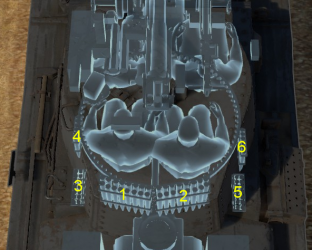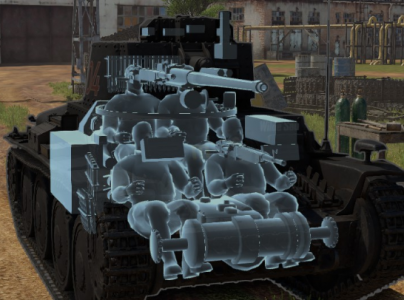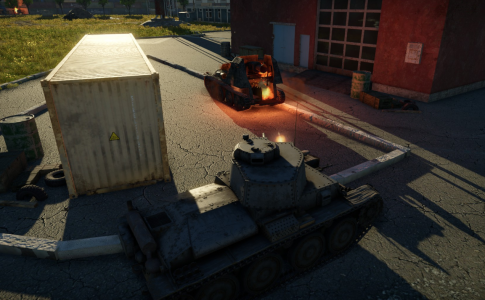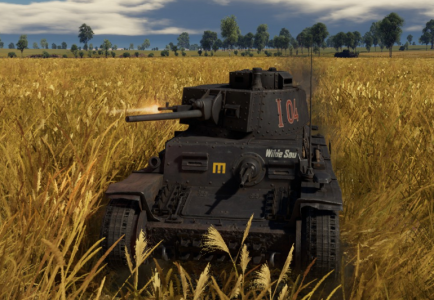Difference between revisions of "Pz.38(t) F"
(→Survivability and armour: Added notes) |
(→Survivability and armour: Completed section) |
||
| Line 15: | Line 15: | ||
== General info == | == General info == | ||
=== Survivability and armour === | === Survivability and armour === | ||
| − | <!-- ''Describe armour protection. Note the most well protected and key weak areas. Appreciate the layout of modules as well as the number and location of crew members. Is the level of armour protection sufficient, is the placement of modules helpful for survival in combat? If necessary use a visual template to indicate the most secure and weak zones of the armour.'' | + | <!-- ''Describe armour protection. Note the most well protected and key weak areas. Appreciate the layout of modules as well as the number and location of crew members. Is the level of armour protection sufficient, is the placement of modules helpful for survival in combat? If necessary use a visual template to indicate the most secure and weak zones of the armour.'' --> |
| − | |||
'''Armour type:''' | '''Armour type:''' | ||
| Line 27: | Line 26: | ||
! Armour !! Front (Slope angle) !! Sides !! Rear !! Roof | ! Armour !! Front (Slope angle) !! Sides !! Rear !! Roof | ||
|- | |- | ||
| − | | Hull || | + | | Hull || 50 mm (20°) ''Front plate'' <br> 30 mm (74°) ''Upper glacis'' <br> 50 mm (15°) ''Lower glacis'' <br> 8 mm (68°) ''Bottom junction glacis'' || 30 mm || 30 mm (14°) || 30 mm (16°) ''Front glacis'' <br> 15 mm ''Turret section'' <br> 15 mm (0-30°) ''Rear section'' |
|- | |- | ||
| − | | Turret || | + | | Turret || 50 mm (10°) ''Turret front'' <br> 25 mm + 50 mm (10°) ''Gun mantlet'' || colspan="2" style="text-align:center" | 30 mm (8°) || 8 mm |
|- | |- | ||
| − | | Cupola || | + | | Cupola || colspan="3" style="text-align:center" | 15 mm || 8 mm |
|- | |- | ||
|} | |} | ||
Revision as of 22:01, 6 September 2020
Contents
| This page is about the German light tank Pz.38(t) F. For other uses, see LT-38 (Family). |
Description
The Pz.Kpfw. 38(t) Ausf. F is a rank German light tank
with a battle rating of (AB), (RB), and (SB). It was introduced in Update 1.41.
The Pz.Kpfw. 38(t) Ausf.F variant is an up-armoured version of its predecessor: the Ausf. A. Notably, armour on all sides has been doubled from 25/15/15 mm to a decent 50/30/30 mm. However, the increased armour thickness brings additional weight, making this tank a bit slower than the Ausf. A variant. The cannon remains the same, a decent, quick-firing 3,7 cm Kwk 38(t) L/48. The vehicle can certainly hold its ground at this BR, although usage of APCR ammo is sometimes necessary, and the cannon's damage output is sometimes lacking compared to other vehicles at this rank.
General info
Survivability and armour
Armour type:
- Rolled homogeneous armour (hull, turret, cupola)
- Cast homogeneous armour (gun mantlet)
| Armour | Front (Slope angle) | Sides | Rear | Roof |
|---|---|---|---|---|
| Hull | 50 mm (20°) Front plate 30 mm (74°) Upper glacis 50 mm (15°) Lower glacis 8 mm (68°) Bottom junction glacis |
30 mm | 30 mm (14°) | 30 mm (16°) Front glacis 15 mm Turret section 15 mm (0-30°) Rear section |
| Turret | 50 mm (10°) Turret front 25 mm + 50 mm (10°) Gun mantlet |
30 mm (8°) | 8 mm | |
| Cupola | 15 mm | 8 mm | ||
Notes:
- Suspension wheels, tracks and torsion bars are 15 mm thick.
- The belly of the tank is 8 mm thick
- Mudguards are 4 mm thick.
The Pz.38(t) F has similarly bad survivability as the Pz.35(t) and Pz.38(t) A, but it boasts double the front hull and turret front armour. This makes it frontally immune to many reserve-tier guns, particularly Japanese, French, and Italian ones. But while it is harder to initially penetrate, its internal components are still weak and your battle rating is also higher. Angling your hull will increase your chances of surviving a hit.
Mobility
| Game Mode | Max Speed (km/h) | Weight (tons) | Engine power (horsepower) | Power-to-weight ratio (hp/ton) | |||
|---|---|---|---|---|---|---|---|
| Forward | Reverse | Stock | Upgraded | Stock | Upgraded | ||
| Arcade | Expression error: Unexpected * operator. | 194 | Expression error: Unexpected round operator. | __.__ | |||
| Realistic | 111 | Expression error: Unexpected round operator. | __.__ | ||||
The Pz.38(t) F has nearly identical mobility to the Pz.38(t) A, aside being slightly more sluggish. It is often wise to use this mobility to locate and acquire ambushing positions against the enemy.
Armaments
Main armament
| 37 mm KwK38(t) | Turret rotation speed (°/s) | Reloading rate (seconds) | |||||||||||
|---|---|---|---|---|---|---|---|---|---|---|---|---|---|
| Mode | Capacity | Vertical | Horizontal | Stabilizer | Stock | Upgraded | Full | Expert | Aced | Stock | Full | Expert | Aced |
| Arcade | 90 | -10°/+25° | ±180° | Shoulder-stop, Vertical | 13.33 | 18.45 | __.__ | __.__ | 26.35 | 4.29 | _.__ | _.__ | 3.3 |
| Realistic | 8.33 | 9.8 | __.__ | __.__ | 14.0 | ||||||||
This vehicle has the same cannon as the Pz.38(t) A. It is slightly better than the Pz.35(t)'s gun, but not by a significant amount, and therefore is used in exactly the same way. A 56 mm penetration APC-HE round, a 61 mm penetration APCBC-HE round, and a 93 mm penetration APCR round brings options for dealing with any type of ground target. The cannon easily dispatches most things it encounters, but may have trouble penetrating Valentines, the B1 bis and ter, Matildas, and Sherman 105s.
Ammunition
The ammunition available to the Pz.38(t) F allows for engaging all types of targets:
- Pzgr. 34(t): APC; a shell with explosive filler but an average penetration power. It should be the main ammunition used in battle.
- PzGr 40: APCR; a composite round with the best penetration but no explosive filler and that will only penetrate flat vertical surfaces. Pack a few of these shells to use against heavily armoured foes that the Pzgr. 34(t) can't penetrate.
- Pzgr. 34(t): APC; a shell offering a penetration power similar to Pzgr. 34(t) while being a bit faster and slighty lighter.
| Penetration statistics | |||||||
|---|---|---|---|---|---|---|---|
| Ammunition | Type of warhead |
Penetration @ 0° Angle of Attack (mm) | |||||
| 10 m | 100 m | 500 m | 1,000 m | 1,500 m | 2,000 m | ||
| Pzgr. 34(t) | APC | 62 | 59 | 45 | 32 | 23 | 17 |
| PzGr. 40 | APCR | 86 | 77 | 47 | 26 | 14 | 8 |
| Pzgr.(t) umg. | APC | 61 | 58 | 44 | 31 | 22 | 15 |
| Shell details | |||||||||
|---|---|---|---|---|---|---|---|---|---|
| Ammunition | Type of warhead |
Velocity (m/s) |
Projectile Mass (kg) |
Fuse delay (m) |
Fuse sensitivity (mm) |
Explosive Mass (TNT equivalent) (g) |
Ricochet | ||
| 0% | 50% | 100% | |||||||
| Pzgr. 34(t) | APC | 741 | 0.85 | 1.2 | 9.0 | 22.1 | 48° | 63° | 71° |
| PzGr. 40 | APCR | 1,020 | 0.37 | N/A | N/A | N/A | 66° | 70° | 72° |
| Pzgr.(t) umg. | APC | 750 | 0.82 | 1.2 | 9.0 | 22.1 | 48° | 63° | 71° |
Ammo racks

| Full ammo |
1st rack empty |
2nd rack empty |
3rd rack empty |
4th rack empty |
5th rack empty |
6th rack empty |
Visual discrepancy |
|---|---|---|---|---|---|---|---|
| 90 | 76 (+14) | 61 (+29) | 46 (+44) | 31 (+59) | 16 (+74) | 1 (+89) | Yes |
Notes:
- The visual discrepancy concerns the number of shells per rack as well as the total number of sells (72 shells modeled for 90 available).
- Rack 1 & 2 are modeled as 16 shells each, racks 3 & 5 as 14 shells each and racks 4 &6 as 6 shells each. However, each rack will disappear after you've fired 15 shells from it.
- Turret empty: 61 (+29) shells.
Machine guns
| 7.92 mm MG37(t) | ||||
|---|---|---|---|---|
| Mount | Capacity (Belt) | Fire rate | Vertical | Horizontal |
| Coaxial | 5500 (200) | 769 | N/A | N/A |
The small caliber of the MG37(t) machine gun makes it largely ineffective against all armoured vehicles but the ones with an open compartment.
Usage in battles
The tank has the same average mobility of its predecessors, and plays very similarly to them as well. Watch out for heavily armoured enemies such as the B1 bis, Valentine, and Matilda.
Modules
| Tier | Mobility | Protection | Firepower | ||
|---|---|---|---|---|---|
| I | Tracks | Parts | Horizontal Drive | Pzgr.(t) umg. | |
| II | Suspension | Brake System | FPE | Adjustment of Fire | PzGr. 40 |
| III | Filters | Crew Replenishment | Elevation Mechanism | Smoke grenade | |
| IV | Transmission | Engine | Artillery Support | ||
Pros and cons
Pros:
- Decently good gun with HE-filled rounds
- Good armour
- High-penetration APCR shells can penetrate almost all enemies
Cons:
- Slower than many tanks
- The small crew compartment provides low survivability
- Inadequate gun when up-tiered
History
Development
In 1935, ČKD (Českomoravská Kolben-Daněk), the tank manufacturer in Czechoslovakia, wanted to find a replacement to the LT vz.35 (also known as the Panzer 35(t) in German service). The reason was that the vz.35 was overly complex and had faults that impeded its efficiency. Orders for new tanks would be coming from the gradually growing Czechoslovak army, and so they worked jointly with Škoda Works in the development of this new tank.
The next tank design, designated in Czechoslovakia as the LT vz.38, was a conventional model for the interwar period. The armour was riveted with 25 mm thick plates in the front hull and was not sloped. A new model was needed with a complete overhaul. The engine was placed in the rear of the tank, with a two-man turret in the centre and the driving compartment in the front with a front transmission. Perhaps the most significant feature of this tank design was the use of a leaf-spring unit suspension consisting of four large wheels. The turret housed the 37 mm Skoda A7 cannon, with about 90 rounds of ammunition stored in the vehicle. Unlike traditional designs, the coaxial machine gun was mounted on a ball mount, allowing it to be aimed independently on targets. It could also be fixed for coaxial usage. A second machine gun in the front could be used by the assistant driver, who also doubled as the radio operator placed on the left of the driver, who was on the right side of the tank. The LT vz.38 was a very reliable design and other nations either ordered tanks (Peru) or purchased a license for production (Sweden).
The LT vz.38 was successfully exported under the name "TNH". It was given to Iran, Peru, Switzerland, and Lithuania, all under different names, but only in small quantities (Iran bought the most at 50 units). The British Royal Armoured Corps ordered one trial model for an evaluation, but their data showed that the vehicle was uncomfortable for the crew. It was impossible to aim the gun when the tank is in motion; thus, the British did not order any and returned the trial model. Then in 1937, the Czechoslovak armed forces started a contest for a new tank to be put into service. Three companies, Škoda, ČKD, and Tatra, were involved and submitted their various designs with Škoda a variant of the LT vz.38, ČKD a prototype model different from the LT vz.38, and Tatra a very different design concept altogether. The army then chose the LT vz.38 model and ordered 150 units in July 1938, but these were never put to service in Czech usage when Germans occupied Czechoslovakia in March 1939.
German adoption
When Germany took control of Czechoslovakia, they ordered the LT vz.38 production to continue as its firepower, armour, and mobility was considerably better than that of the Panzer I and Panzer II, which made up most of the German armoured forces in 1939. At first, it was used under the designation LTM 38, but this was changed in January 1940 to the Panzerkampfwagen 38(t), or the Panzer 38(t) for short. The Panzer 38(t) was used as a substitute for the Panzer III due to the similarity in armour and armament. The 37 mm Skoda A7 cannon was renamed the 37 mm KwK38 (t). The Germans would gradually upgrade the design in its production life and have seven different variants (A-G). The armour plates classified each option; one with 25 mm of frontal riveted armour originally, and the other with a total frontal armour thickness of 50 mm by bolting on another 25 mm of armour to the hull. Production under Germany control continued from 1939 to 1942, with a total of 1,414 tank units built (excluding export models and other vehicles built with the chassis).
Combat usage
The Panzer 38(t) served well in the initial campaigns for Germany in World War II, performing well in the invasion of Poland and France in 1939 and 1940 respectively. Some notable German tank aces would start their careers with this tank; such as Otto Carius, who would become one of Germany's well known Tiger aces. Though unable to deal with the heavier tanks in Allied service, it was able to engage the armour of most light tank designs at the time. It wasn't until the initiation of Operation Barbarossa, the invasion of the Soviet Union, where the Panzer 38(t) would become outclassed in all ways by the Soviet T-34s and KV-1 tanks. Due to the small two-man turret, it could not be modified to accept a larger gun capable of defeating these tanks. Not only that, but the Panzer 38(t) was also vulnerable to the Soviet 47 mm anti-tank gun due to the lower armour quality on the tank. These two drawbacks of the Panzer 38(t) caused it to be retired from front-line services for better tanks such as the Panzer IV. Despite its retirement, the chassis was found to be a very adaptable design, so it would continue to be used in a variety of roles such as the Marder III and Jagdpanzer 38(t) tank destroyer, Flakpanzer 38(t) anti-aircraft gun, and the Grille self-propelled artillery piece. A dedicated reconnaissance variant known as the Aufklärungspanzer 38(t) was also built to supplement the need for reconnaissance vehicles.
Despite its retirement as a front-line weapon, the Panzer 38(t) tank still saw usage as a reconnaissance vehicle and an anti-partisan vehicle in German-controlled territory. The usage of the chassis in different roles freed up many turrets to serve as fortifications to be used in a variety of locations, such as the Atlantic Wall, which proved well in against infantry attacks as its small 37 mm cannon was inadequate against the increasing armour of Allied tanks.
Other Countries
The Panzer 38(t), as a widely exported tank model, also saw service with Romania, Kingdom of Bulgaria, Hungary, Slovak Republic, Sweden, Switzerland, Peru, and Iran. Sweden was one of the few countries that were granted a license to construct the Panzer 38(t) under their designation as the Stridsvagn m/41 after their initial batch were seized by the Germans with the takeover of Czechoslovakia. Deliveries of the first batch of the initial tank model started in December 1942 and ended in August 1943. Then a second batch of 122 units was ordered in mid-1942 for more of these tanks due to urgent demand, the second batch would have the 50 mm armour plate thickness and with a redesigned interior and better engine to compensate the weight increase. 104 of the second batch were delivered before production ended in March 1944. Some of these tanks would be converted into sav M/43 assault guns or armoured personnel carriers during and after the war. Peru was also another prolific user of the Panzer 38(t), using them in the Ecuadorian-Peruvian War in 1941 as the mainstay of their tank battalions. The tanks along with the lack of capable anti-tank weapons in Ecuadorian forces made the Panzer 38(t) very successful in the war and even stayed in service for more than 50 years before being retired.
In-game description
A modified version of the Pz.38(t) light tank designed on the basis of combat experience in Poland. The tank's armor was enhanced to 50 mm in the front and 30 mm on the sides. Two similar versions of the Pz. 38(t) Ausf. E and Ausf F were released between November, 1940 and October, 1941. 525 tanks were produced, including both versions.
Media
See also
- Pz.38(t) A: a predecessor in the German ground tree
External links
- Official War Thunder forum article: [Vehicle Profile] Pz.Kpfw. 38(t) Ausf. A & F
- Official War Thunder forum article: [Legends] Panzerkampfwagen 38(t)
| Germany light tanks | |
|---|---|
| Pz.II | Pz.II C · Pz.II C (DAK) · Pz.II C TD · Pz.II F · Pz.Sfl.Ic |
| Sd.Kfz.234 | Sd.Kfz.234/1 · Sd.Kfz.234/2 · Sd.Kfz.234/2 TD |
| Marder | Marder A1- · Marder 1A3 · Begleitpanzer 57 · DF105 |
| SPz PUMA | PUMA · PUMA VJTF |
| Wheeled | Sd.Kfz.221 (s.Pz.B.41) · Class 3 (P) · Radkampfwagen 90 · Boxer MGS |
| Other | Ru 251 · SPz 12-3 LGS |
| Argentina | TAM · TAM 2C · TAM 2IP · JaPz.K A2 |
| Czechoslovakia | Pz.35(t) · Pz.38(t) A · Pz.38(t) F · Pz.38(t) n.A. · Sd.Kfz. 140/1 |
| France | Pz.Sp.Wg.P204(f) KwK |
| Lithuania | Vilkas |
| USA | leKPz M41 |
| USSR | SPz BMP-1 |








